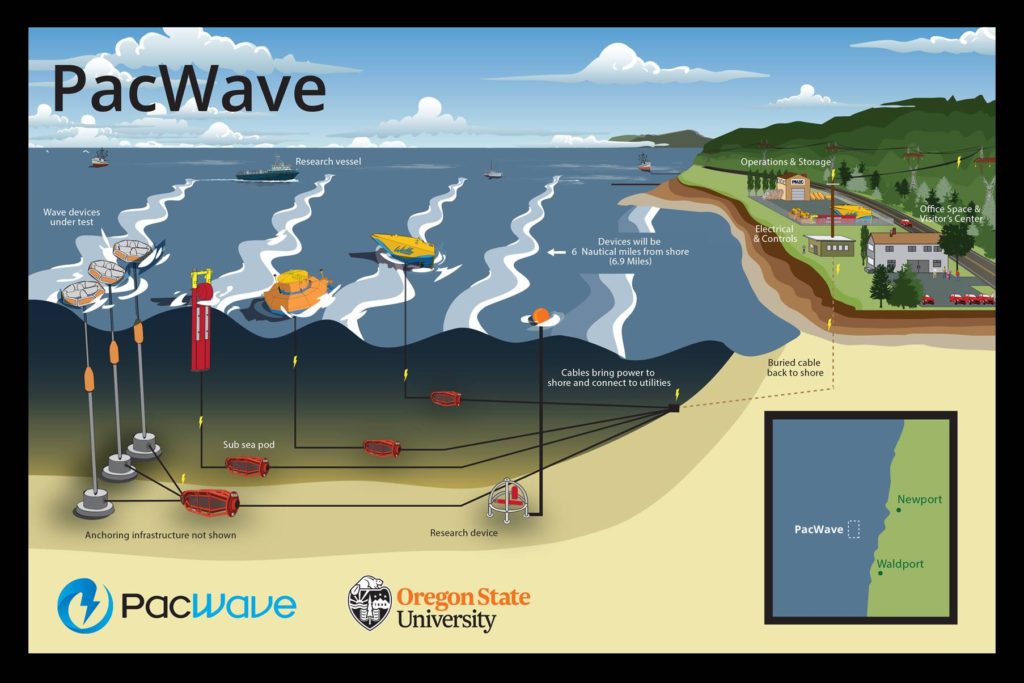
PETE DANKO/Portland Business Journal
With a big pot of federal money in hand, Oregon State University trustees have approved a $73.5 million capital budget for PacWave, a project just north of Waldport that backers hope will solidify the state’s status as a world leader in wave-energy research and development.
OSU’s Burke Hales, chief scientist for the planned grid-connected test center, said the university’s sign-off in June was the latest of several “critical benchmarks” the project hit in the past few months.

PacWave isn’t quite home free, but Hales, a self-confessed worrier, said there are a dwindling number of issues that could sink it.
“We are waiting for remaining state agencies to respond to the environmental assessment, and believe the project is meeting those agencies’ concerns,” he said.
PacWave is envisioned as the ultimate proving ground for wave-energy technologies, offering four testing berths each capable of handling up to five devices. Set about seven miles off the coast between Newport and Waldport, it would give developers access to what Hales called “one of the most consistently energetic wave environments in the world” at a site permitted for a wide range of device types.
The idea of locating a test center off Oregon’s coast dates to early last decade. It has survived the disappointingly slow progress of wave technology, competition from a California group and, most recently, a more realistic assessment of the project’s cost.
That turned what was billed as a $50 million project into one costing $82.5 million, including $9 million for operational costs.
Congress came through, though. Late last year it added $26 million to $35 million appropriated more than three years ago, and did so without increasing the project’s required funding match. The U.S. Department of Energy recently released the additional funds.
The state of Oregon ($5.4 million) and OSU ($3 million) have committed to the bulk of the matching funds, and the Murdock Charitable Trust is providing $740,000. That leaves a small hole in the approximately $10 million the project needs to raise for direct expenses.
Hales said he’s hopeful that moving into the construction phase will galvanize fundraising to fill the hole and perhaps drive down OSU’s required contribution.
With construction set to begin soon, Hales said Oregon companies appeared to be strong contenders to do the underground boring the project will require.
The electrical cables would be buried 3-6 feet in the ocean floor and run seven miles southwest from a point south of Newport, coming ashore at Driftwood Beach State Recreation Site north of Seal Rock. From there, the buried cables would go farther south to a testing facility being built on a former Christmas tree farm on the east side of Highway 101.
The longer-term economic-impact hope for Oregon, which spent $12 million from 2007 to 2017 to seed a wave-energy industry in the state, is that the test center will draw developers to the region after it comes online in 2022. Not just to deploy, but for design and fabrication as well.
Vigor’s work in Portland on a wave energy converter for Irish company Ocean Energy, on a $6.5 million contract completed last year, hinted at the possibilities. That project was supported by the U.S. government and the feds are backing other efforts, including one by Columbia Power Technologies, which has a nine-person development team in Corvallis.
PacWave will also provide renewable power to the Central Lincoln People’s Utility District, with a rated capacity of 20 megawatts. That said, as a test facility, production over the long haul is likely to be a small fraction of that figure. If PacWave averages 2 megawatts of output over the course of a year, that would equal the energy use of about 1,600 Oregon households.



This seems like a dangerous situation for our large commercial fishing and recreational boating port. Wave generators in the ocean 7 miles west of Newport – as a regular recreational sailboater, I’d say a hazard to navigation for boats and ships big and small.